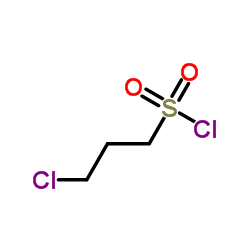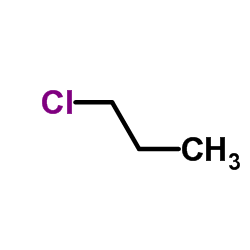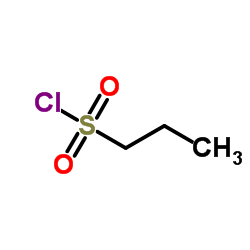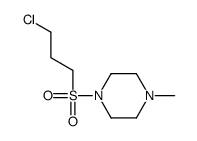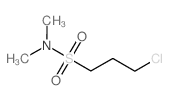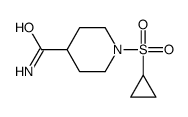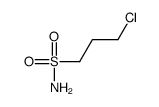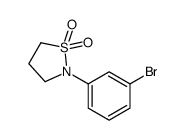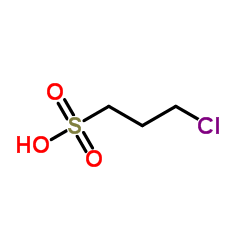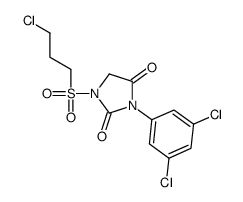1633-82-5
| 中文名 | 3-氯丙烷磺酰氯 |
|---|---|
| 英文名 | 3-Chloropropanesulfonyl chloride |
| 中文别名 | 3-氯丙磺酰氯 |
| 英文别名 |
EINECS 216-646-3
3-Chloro-1-propanesulfonyl chloride γ-Chloropropanesulfonyl chloride MFCD00007463 3-Chloropropane-1-sulfonyl chloride |
| 密度 | 1.5±0.1 g/cm3 |
|---|---|
| 沸点 | 262.1±0.0 °C at 760 mmHg |
| 分子式 | C3H6Cl2O2S |
| 分子量 | 177.049 |
| 闪点 | 92.3±22.6 °C |
| 精确质量 | 175.946548 |
| PSA | 42.52000 |
| LogP | 1.22 |
| 外观性状 | 透明无色液体 |
| 蒸汽压 | 0.0±0.5 mmHg at 25°C |
| 折射率 | 1.477 |
| 储存条件 | 室温 |
| 计算化学 | 1.疏水参数计算参考值(XlogP):1.3 2.氢键供体数量:0 3.氢键受体数量:2 4.可旋转化学键数量:3 5.互变异构体数量:无 6.拓扑分子极性表面积42.5 7.重原子数量:8 8.表面电荷:0 9.复杂度:134 10.同位素原子数量:0 11.确定原子立构中心数量:0 12.不确定原子立构中心数量:0 13.确定化学键立构中心数量:0 14.不确定化学键立构中心数量:0 15.共价键单元数量:1 |
Synonym:Gamma-Chloropropanesulfonyl Chloride Section 2 - COMPOSITION, INFORMATION ON INGREDIENTS
Risk Phrases: 34 Section 3 - HAZARDS IDENTIFICATION EMERGENCY OVERVIEW
Causes burns.Corrosive.Moisture sensitive.Lachrymator (substance which increases the flow of tears). Potential Health Effects Eye: Causes eye burns. Lachrymator (substance which increases the flow of tears). May cause chemical conjunctivitis and corneal damage. Skin: Causes skin burns. May cause skin rash (in milder cases), and cold and clammy skin with cyanosis or pale color. Ingestion: May cause severe and permanent damage to the digestive tract. Causes gastrointestinal tract burns. May cause perforation of the digestive tract. May cause systemic effects. Inhalation: May cause severe irritation of the respiratory tract with sore throat, coughing, shortness of breath and delayed lung edema. Causes chemical burns to the respiratory tract. Aspiration may lead to pulmonary edema. May cause systemic effects. Chronic: Effects may be delayed. Section 4 - FIRST AID MEASURES Eyes: Get medical aid immediately. Do NOT allow victim to rub eyes or keep eyes closed. Extensive irrigation with water is required (at least 30 minutes). Skin: Get medical aid. Immediately flush skin with plenty of water for at least 15 minutes while removing contaminated clothing and shoes. Wash clothing before reuse. Destroy contaminated shoes. Ingestion: Do not induce vomiting. If victim is conscious and alert, give 2-4 cupfuls of milk or water. Never give anything by mouth to an unconscious person. Get medical aid immediately. Inhalation: Get medical aid immediately. Remove from exposure and move to fresh air immediately. If breathing is difficult, give oxygen. Do NOT use mouth-to-mouth resuscitation. If breathing has ceased apply artificial respiration using oxygen and a suitable mechanical device such as a bag and a mask. Notes to Physician: Section 5 - FIRE FIGHTING MEASURES General Information: As in any fire, wear a self-contained breathing apparatus in pressure-demand, MSHA/NIOSH (approved or equivalent), and full protective gear. During a fire, irritating and highly toxic gases may be generated by thermal decomposition or combustion. Will burn if involved in a fire. Use water spray to keep fire-exposed containers cool. Vapors may be heavier than air. They can spread along the ground and collect in low or confined areas. Containers may explode when heated. Extinguishing Media: Do NOT get water inside containers. For small fires, use dry chemical, carbon dioxide, or water spray. For large fires, use dry chemical, carbon dioxide, alcohol-resistant foam, or water spray. Cool containers with flooding quantities of water until well after fire is out. Section 6 - ACCIDENTAL RELEASE MEASURES General Information: Use proper personal protective equipment as indicated in Section 8. Spills/Leaks: Avoid runoff into storm sewers and ditches which lead to waterways. Clean up spills immediately, observing precautions in the Protective Equipment section. Remove all sources of ignition. Absorb spill using an absorbent, non-combustible material such as earth, sand, or vermiculite. Do not use combustible materials such as sawdust. Provide ventilation. Do not get water inside containers. Section 7 - HANDLING and STORAGE Handling: Use only in a well-ventilated area. Do not breathe dust, vapor, mist, or gas. Do not get in eyes, on skin, or on clothing. Keep container tightly closed. Do not ingest or inhale. Do not allow contact with water. Discard contaminated shoes. Keep from contact with moist air and steam. Storage: Keep container closed when not in use. Corrosives area. Store protected from moisture. Section 8 - EXPOSURE CONTROLS, PERSONAL PROTECTION Engineering Controls: Facilities storing or utilizing this material should be equipped with an eyewash facility and a safety shower. Use adequate ventilation to keep airborne concentrations low. Exposure Limits CAS# 1633-82-5: Personal Protective Equipment Eyes: Wear appropriate protective eyeglasses or chemical safety goggles as described by OSHA's eye and face protection regulations in 29 CFR 1910.133 or European Standard EN166. Skin: Wear appropriate protective gloves to prevent skin exposure. Clothing: Wear appropriate protective clothing to prevent skin exposure. Respirators: A respiratory protection program that meets OSHA's 29 CFR 1910.134 and ANSI Z88.2 requirements or European Standard EN 149 must be followed whenever workplace conditions warrant respirator use. Section 9 - PHYSICAL AND CHEMICAL PROPERTIES Physical State: Liquid Color: clear, colorless Odor: chlorine-like pH: Not available. Vapor Pressure: Not available. Viscosity: Not available. Boiling Point: 70 deg C @ .50mm Hg Freezing/Melting Point: Not available. Autoignition Temperature: Not available. Flash Point: > 109 deg C (> 228.20 deg F) Explosion Limits, lower: Not available. Explosion Limits, upper: Not available. Decomposition Temperature: Solubility in water: Specific Gravity/Density: 1.4560g/cm3 Molecular Formula: C3H6Cl2O2S Molecular Weight: 177.05 Section 10 - STABILITY AND REACTIVITY Chemical Stability: Stable at room temperature in closed containers under normal storage and handling conditions. Conditions to Avoid: Incompatible materials, ignition sources, moisture, excess heat. Incompatibilities with Other Materials: Moisture, alcohols, strong bases, strong oxidizing agents. Hazardous Decomposition Products: Hydrogen chloride, carbon monoxide, oxides of sulfur, irritating and toxic fumes and gases, carbon dioxide, hydrogen sulfide. Hazardous Polymerization: Has not been reported Section 11 - TOXICOLOGICAL INFORMATION RTECS#: CAS# 1633-82-5: TZ6670000 LD50/LC50: Not available. Carcinogenicity: 3-Chloropropanesulfonyl Chloride - Not listed by ACGIH, IARC, or NTP. Other: See actual entry in RTECS for complete information. Section 12 - ECOLOGICAL INFORMATION Section 13 - DISPOSAL CONSIDERATIONS Dispose of in a manner consistent with federal, state, and local regulations. Section 14 - TRANSPORT INFORMATION IATA Shipping Name: CORROSIVE LIQUID, N.O.S.* Hazard Class: 8 UN Number: 1760 Packing Group: II IMO Shipping Name: CORROSIVE LIQUID, N.O.S. Hazard Class: 8 UN Number: 1760 Packing Group: II RID/ADR Shipping Name: CORROSIVE LIQUID, N.O.S. Hazard Class: 8 UN Number: 1760 Packing group: II Section 15 - REGULATORY INFORMATION European/International Regulations European Labeling in Accordance with EC Directives Hazard Symbols: C Risk Phrases: R 34 Causes burns. Safety Phrases: S 24/25 Avoid contact with skin and eyes. S 26 In case of contact with eyes, rinse immediately with plenty of water and seek medical advice. WGK (Water Danger/Protection) CAS# 1633-82-5: No information available. Canada None of the chemicals in this product are listed on the DSL/NDSL list. CAS# 1633-82-5 is not listed on Canada's Ingredient Disclosure List. US FEDERAL TSCA CAS# 1633-82-5 is not listed on the TSCA inventory. It is for research and development use only. SECTION 16 - ADDITIONAL INFORMATION N/A |
CHEMICAL IDENTIFICATION
HEALTH HAZARD DATAACUTE TOXICITY DATA
|
| 符号 |


GHS05, GHS07 |
|---|---|
| 信号词 | Danger |
| 危害声明 | H314-H335 |
| 警示性声明 | P261-P280-P305 + P351 + P338-P310 |
| 个人防护装备 | Faceshields;full-face respirator (US);Gloves;Goggles;multi-purpose combination respirator cartridge (US);type ABEK (EN14387) respirator filter |
| 危害码 (欧洲) | C:Corrosive; |
| 风险声明 (欧洲) | R34;R36/37 |
| 安全声明 (欧洲) | S26-S36/37/39-S45-S24/25 |
| 危险品运输编码 | UN 3265 8/PG 2 |
| WGK德国 | 3 |
| RTECS号 | TZ6670000 |
| 包装等级 | II |
| 危险类别 | 8 |
| 海关编码 | 2904909090 |
| 上游产品 10 | |
|---|---|
| 下游产品 10 | |
| 海关编码 | 2904909090 |
|---|---|
| 中文概述 | 2904909090 其他烃的磺化、硝化、亚硝化衍生物(不论是否卤化). 增值税率:17.0% 退税率:9.0% 监管条件:无 最惠国关税:5.5% 普通关税:30.0% |
| 申报要素 | 品名, 成分含量, 用途 |
| Summary | HS:2904909090 sulphonated, nitrated or nitrosated derivatives of hydrocarbons, whether or not halogenated VAT:17.0% Tax rebate rate:9.0% Supervision conditions:none MFN tariff:5.5% General tariff:30.0% |


